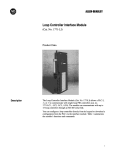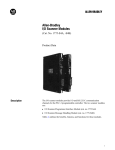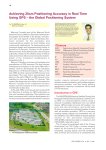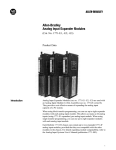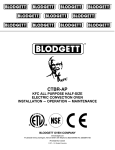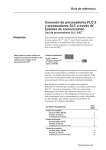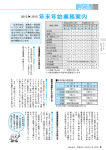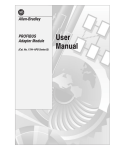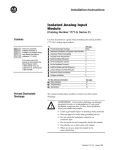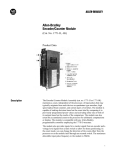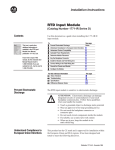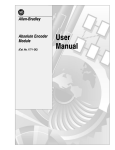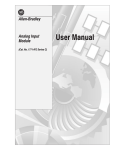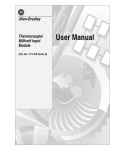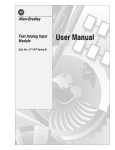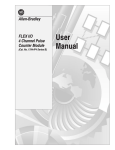Download 1771-2.230, PLC BASIC Module, Product Data
Transcript
(Cat. No. 1771-DB, Series B) Product Data The PLC BASIC module occupies one slot in the 1771I/O chassis and runs user-written BASIC and C programs independently of your PLC processor to provide an easy, fast interface between a PLC processor, the 1771 I/O backplane and RS-232, -422, and -485 devices. The BASIC module can also communicate with a remote SLC processor or a remote device on the DH-485 network. Using the BASIC module you can: communicate with applications requiring remote communications such as computers, modems, printers and other third-party devices manipulate and analyze input and output information gathered from the PLC processor calculate complex math or application-specific algorithms, helping conserve valuable PLC program memory generate unattended reports Notes Benefits Shorten Your Processing Time. Now you can program and run BASIC programs faster than ever. The 1771-DB/B BASIC module operates four plus times faster than before. With a C tool kit and C compiler from one of our Pyramid Solutions Program Partners, you can run C programs on the BASIC module even faster. See your Allen-Bradley representative for more details on the C tool kit. You can also run the BASIC module at the same speed as the Series A BASIC module for applications that cannot run at a faster speed. With the BASIC Development Software (1746-PBASE) you can shorten program development time. This powerful programming tool provides a high level BASIC programming language, powerful debugger, ASCII terminal emulator, and a thorough Help system to streamline BASIC module programming and troubleshooting. Improve Troubleshooting Efforts with New LED Indicators. The Series B module has an additional five LED indicators to aid in your trouble-shooting efforts. You now have LED indicators to let you know when PRT1 is transmitting, PRT2 is transmitting, PRT1 is receiving, and PRT2 is receiving. In addition, you have two user-defined LED indicators. Three Fully Functional Serial Ports Provide Interfaces between Your Process and the PLC Processor. The BASIC module has three serial ports for independent communication links: DH485 – use this port as a DH-485 network port or a programming port PRT1 – use this port as a program port or an ASCII port. You can configure PRT1 for RS-232, RS-422, or RS-485 communications. PRT2 – use this port as an ASCII port or a DF1 protocol port. You can configure PRT2 for RS-232, RS-422, or RS-485 communications. Program Serial Communications Easily. With the BASIC module’s new enhanced serial port statements (EOF, INPS, INPL) and port statement modifiers (# and @) serial communications program development becomes easy. When you use the @ operator you direct communications to port PRT1. When you use the # statement modifier you direct communications to port PRT2. It’s that simple. Complement PLC Ladder Logic with a Familiar Programming Language. The BASIC module uses a subset of the Intel BASIC 52 programming language. The module supports the BASIC commands and statements you are familiar with along with an additional 128 calls specific to the BASIC module, including 43 new calls. Your programs run asynchronously to and independently of the PLC control logic, but have access to the PLC processor’s memory. You can use PLC control logic programs to start and stop your BASIC programs. 2 BASIC Module Product Data Benefits Perform Operations in Background While a BASIC Program Executes. Perform such operations as reading bar code data or writing to a remote display device at the same time your BASIC program executes. You can do just that with the newly added BASIC calls: CALL 33 CALL 34 CALL 49 CALL 50 transfer data from PRT1/PRT2 to BTR buffer transfer data from BTW buffer to PRT1/PRT2 read remote DHĆ485 SLC data file write to remote DHĆ485 SLC data file Examine Bits 10-17 for Communication Port Status. With the BASIC module configured for 16-bit operation you can examine bits 10 – 17 for communication port status. These bits are especially useful in these newly added calls: CALL 32 CALL 33 CALL 34 CALL 49 CALL 50 CALL 118 CALL 122 CALL 123 enable/disable processor interrupt transfer data from PRT1/PRT2 to BTR buffer transfer data from BTW buffer to PRT1/PRT2 read remote DHĆ485 SLC data file write to remote DHĆ485 SLC data file PLC/SLC unsolicited writes read remote DF1 PLC data file write to remote DF1 PLC data file When the BASIC module is configured for either 8-bit or 16-bit operation, bits 1–8 in both the input and output image tables are used for block transfer. Configuration: Input image bits Output image bits Read block words Write block words 8Ćbit 8 8 64 max 16Ćbit¬ 16 16 64 max ¬ 2Ćslot chassis addressing not allowed. Block transfers must be synchronous. 64 max 64 max Communicate To One or More PLC Programmable Controllers. You can communicate to PLC processors across the 1771 I/O backplane or to a remote SLC processor or remote device on the DH-485 network through the DH485 port. Use DF1 Protocol To Communicate Using a Modem. You can configure port PRT2 for DF1 protocol. You can implement the DF1 protocol in full-duplex or half-duplex mode. With the DF1 protocol you can communicate with remote devices using, for example, a leased phone line, radio link, or dial-up modem. Benefits 3 The BASIC module is a single-slot module that resides in an I/O chassis. The BASIC module provides math functions, report generation and BASIC language capabilities for any Allen-Bradley processor that communicates with the 1771 I/O system using block-transfer. Reset switch Reset LED Indicators LED Indicators DH485 DH485 port PRT2 port When you press this switch (located behind the module ejector tab), the BASIC module initiates a full reset. The BASIC module reacts to this reset the same as it does when you turn on power to your I/O chassis backplane. 10 LED indicators for module diagnostics and operator indicators. • 8 preĆdefined LED indicators • 2 userĆdefined LED indicators This RJĆ45 port (DH485) provides communication over the DHĆ485 network. Use DH485 port to interface the BASIC module with the DHĆ485 network. This port is not isolated and cannot directly drive the DHĆ485 network. You must use a 1747ĆAIC link coupler to link port DH485 with the DHĆ485 network. You can also use this port as a program port. This independently configurable, isolated 25Ćpin DĆshell serial port provides RSĆ232, RSĆ422, and RSĆ485 communication with I/O devices. Use PRT2 to interface the BASIC module with user devices or a modem using DF1 protocol. PRT2 provides DF1 full-duplex or half-duplex slave protocol for SCADA applications. PRT2 is capable of operating full-duplex at 300, 600, 1200, 2400, 4800, 9600, and 19200 bit/s. It is electrically isolated to 500V dc. PRT1 port PRT2 RAM Battery backup Memory module PRT1 4 4 This independently configurable, isolated 25Ćpin DĆshell serial port provides RSĆ232, RSĆ422, and RSĆ485 communication with I/O devices. Use PRT1 to interface the BASIC module with user devices. PRT1 is capable of operating full-duplex at 300, 600, 1200, 2400, 4800, 9600, and 19200 bit/s. It is electrically isolated to 500V dc. You can also use this port as a program port. 24K bytes of battery backed RAM for storage of user programs and data • batteryĆbacked, 24Ćhour clock/calendar • capacitive backup of RAM during battery change • socket for standard EEPROM and EPROM memory modules with carriers • socket for standard EEPROM and EPROM memory modules without carriers • onĆboard program EEPROM storage 5 ms resolution UserĆaccessible freeĆrunning clock UserĆaccessible 1 s resolution wall clock/calendar Backplane interface • 1771 I/O • supports blockĆtransfers • multiple BASIC modules can reside in the same I/O rack and function independently of each other BASIC Module Product Data Features Software Features Software element Description Programming language Intel BASICĆ52 with enhancements • highĆlevel math functions • full set of trigonometric instructions • string manipulation support • floating point calculations and conversions • extensive call libraries data read and write support with: • PLCĆ2 family processors • PLCĆ3 family processors • PLCĆ5 family processors • PLCĆ5/250 family processors • RAM • memory modules • DHĆ485 network • DF1 protocol • 16Ćbit binary (4 hex digits) • SLC 16Ćbit signed integer • SLC 16Ćbit unsigned integer • 3Ćdigit, signed, fixed decimal BCD • 4Ćdigit, unsigned, fixed decimal BCD • 4Ćdigit, signed, octal • 6Ćdigit, signed, fixed decimal BCD • 3.3 digit, signed, fixed decimal BCD • 32Ćbit IEEE PLCĆ5 floating point Block transfer communication Program and data storage options Communication network support Data type generation Battery Memory Module SKT1 Memory Module SKT2 20371-M Features 5 The BASIC module has 10 indicator LED indicators. Use these LED indicators for diagnostics and operator interface indicators. ACTIVE FLT DH485 BTLO LED1 LED2 PT1X PT2X PT1R PT2R 6 6 Indicates the module mode and whether the BASIC module is receiving power from the backplane. Indicates whether a system power failure was detected during background diagnostics. Indicates whether port DH485 on the BASIC module is active for communication. Indicates whether the voltage of the battery that backs up RAM is low. User definable. LED activated through the user program. User definable. LED activated through the user program. Indicates whether port PRT1 on the BASIC module is transmitting signals. Indicates whether port PRT2 on the BASIC module is transmitting signals. Indicates whether port PRT1 on the BASIC module is receiving signals. Indicates whether port PRT2 on the BASIC module is receiving signals. BASIC Module Product Data Program the BASIC module using a subset of the Intel BASIC 52 programming language. You can program the BASIC module using an ASCII terminal or a personal computer running ASCII terminal emulation software. Allen-Bradley terminal emulation software, the BASIC Development Software (catalog number 1747-PBASE) package, was designed especially for programming the BASIC module. The execution of these programs allow a direct interface with programmable controller ladder logic programs. You can store and execute programs in RAM or in a memory module. You can store one program in RAM and up to 255 independent user-programs in memory module memory. Use an ASCII terminal to enter a BASIC program one line at a time to your BASIC module through port PRT1. The ASCII terminal connected to the BASIC module must be an industrial terminal, workstation, or personal computer that communicates in alphanumeric mode. An ASCII terminal can also be used to display charts or graphs generated by your BASIC program. In this configuration, you connect the RS-232 port on the back of your industrial terminal or personal computer to port PRT1 on your BASIC module. Port PRT1 must be configured as the program port. 7 Programming Interfaces BASIC Development Software Use a personal computer with the BASIC Development Software (PBASE) to create a BASIC program that is then downloaded to the BASIC module. PBASE provides an efficient means to edit, compile, upload, and download BASIC programs to the BASIC module. You can use PBASE with either the RS-232 or the DH485 interface. You must use PBASE software when port DH485 is the program port. RS-232 Interface In this configuration, you connect the serial port on the personal computer to port PRT1 on the BASIC module. The personal computer communicates with the BASIC module through terminal emulation over an RS-232 interface. Port PRT1 is configured as the program port. Null modem cable Personal computer with PBASE software PLC processor with BASIC module DH-485 Interface In this configuration, you interface the serial port on the personal computer with port DH485 on the BASIC module through a 1747-PIC Interface/Converter. The 1747-PIC Interface/Converter converts the RS-232 signals from the personal computer RS-232 serial port to RS-485 format. Port DH485 is configured as the program port. Interface/Converter RSĆ232 to RSĆ485 (1747ĆPIC) 1747ĆC10 cable Personal computer with PBASE software Programming Interfaces 8 8 PLC processor with BASIC module BASIC Module Product Data Your BASIC module may communicate with a DH-485 network. It can also communicate with a remote device through a modem using the DF1 protocol. When using DF1 protocol on port PRT2, port DH485 is disabled. 1747-PIC Interface/Converter/1747-AIC Link Coupler Configuration In this configuration the BASIC module interfaces with a DH-485 network through a 1747-PIC Interface/Converter and a 1747-AIC isolated link coupler. The 1747-PIC interface/converter converts the RS-232 signals from the personal computer RS-232 serial port to RS-485 format. The 1747-AIC link coupler links the converted signals with the DH-485 network and port DH485 on the BASIC module. The 1747-AIC link coupler also provides an interface to the DH-485 network for a personal computer with the BASIC development software. Port DH485 must be configured as the program port in order to communicate with PBASE software via the DH-485 network. Link coupler 1747ĆAIC DHĆ485 communication cable Belden #9842 Personal computer with PBASE software Interface/Converter RSĆ232 to RSĆ485 (1747ĆPIC) SLC 500 controller with SLC 500 BASIC module 1747ĆC11 cable PLC processor with BASIC module Link coupler 1747ĆAIC 1747ĆC11 cable Important: Each BASIC module requires a link coupler port to interface it with the DH-485 network. 9 1747-AIC Link Coupler/1784-KR DH-485 Interface Card Configuration This configuration shows the BASIC module interfaced with a DH-485 network through a 1747-AIC link coupler. The link coupler provides an interface to the DH-485 network for a personal computer with the BASIC development software. In this configuration, a 1784-KR DH-485 Interface Card is installed in the personal computer. Link coupler 1747ĆAIC DHĆ485 communication cable Belden #9842 SLC 500 controller with SLC 500 BASIC module 1747ĆC11 cable 1784ĆKR DHĆ485 interface card PLC processor with BASIC module Link coupler 1747ĆAIC Personal computer PBASE software 10 10 1747ĆC11 cable BASIC Module Product Data The BASIC module can use DF1 to control communications with a modem. In this configuration, the BASIC module is interfaced with a DH-485 network through a peer-to-peer communication interface with full-duplex, DF1 protocol. PLC processor with BASIC module Modem Modem DHĆ485 communication cable Belden #9842 Link coupler 1747ĆAIC SLC 500 controller with 1747ĆKE module 1747ĆC13 cable 1747ĆC11 cable Link Coupler 1747ĆAIC Console device Interface/Converter RSĆ232 to RSĆ485 (1747ĆPIC) 1747ĆC11 cable PLC processor with BASIC module 11 Operating temperature 0° C to 60° C (32° F to 140° F) Storage temperature -40° C to 85° C (-40° F to 185° F) 5% to 95% (non-condensing) Relative humidity RAM (stores BASIC programs and protected variables) 24K byte batteryĆbacked optional nonĆvolitile memory modules (stores BASIC programs and port configuration) 8K byte EEPROM (programmable with 1771ĆDB/B) 32K byte EEPROM (programmable with 1771ĆDB/B) 8K byte EPROM (preĆprogrammed with external PROM programmer) 16K byte EPROM (preĆprogrammed with external PROM programmer) 32K byte EPROM (preĆprogrammed with external PROM programmer) 5V dc .75 A Important: The BASIC module receives its power from the 1771-I/O backplane. The power consumption of the BASIC module must be taken into consideration when planning your PLC system. Refer to the documentation supplied with your PLC processor or 1771-I/O equipment for additional information on power supplies and current requirements. 12 12 +3.6 V minimum 200 mV minimum BASIC Module Product Data Specifications Port Isolation Port Isolation Isolation Voltage PRT1 Backplane to Port 500V dc PRT2 Backplane to Port 500V dc PRT1 and PRT2 PRT1 to PRT2 500V dc Important: Port DH485 is not isolated. Clock/Calendar Accuracy Specification Range ± 1 minute/month @ 25° C accuracy + 0, - 6 minute/month @ 60° C Math Precision Range 8 significant digits 1E-127 to .99999999E+127 Maximum Communication Distances Communication Rate (bit/s) Maximum Distance Allowed m (ft) RSĆ232 RSĆ423 RSĆ422 RSĆ485 300 15 (50) 15 (50) 1230 (4000) 1230 (4000) 600 15 (50) 15 (50) 1230 (4000) 1230 (4000) 1200 15 (50) 15 (50) 1230 (4000) 1230 (4000) 4800 15 (50) 15 (50) 1230 (4000) 1230 (4000) 9600 15 (50) 15 (50) 1230 (4000) 1230 (4000) 19200 15 (50) 15 (50) 1230 (4000) 1230 (4000) Specifications 13 8K byte EEPROM memory module (supports turbo speed) 1771ĆDBMEM1 8K byte EEPROM memory module (supports normal speed only) 32K byte EEPROM memory module (supports turbo speed) 1747ĆM1 1771ĆDBMEM2 32K byte EEPROM memory module (supports normal speed only) 8K byte EPROM memory module (supports normal speed only) 32K byte EPROM memory module (supports normal speed only) BASIC Development Software communication cable (72" length, interchangeable with CĆ11 and CĆ20 cables) communication cable (12" length, interchangeable with CĆ10 and CĆ20 cables) communication cable (100" length, interchangeable with CĆ10 and CĆ11 cables) communication cable (36" length, different from CĆ10, CĆ11, CĆ20 cables) personal computer to DHĆ485 interface card interface/converter (RSĆ232 to RSĆ485) link coupler 1747ĆM2 1747ĆM3 1747ĆM4 1747ĆPBASE 1747ĆC10 1747ĆC11 1747ĆC20 1747ĆC13 1784ĆKR 1747ĆPIC 1747ĆAIC The C tool kit is available from one of our Pyramid Solutions Program partners (see Pyramid Solutions Program Product Directory, PSP-5.1). For additional information on these products, refer to your local Allen-Bradley sales office. BASIC Module User Manual BASIC Development Software Programming Manual SLC 500 BASIC Module and BASIC Development Software Product Data 1771Ć6.5.113 1746Ć6.2 1746Ć2.33 PLC, PLC-2, PLC-3, PLC-5 are registered trademarks of the Allen-Bradley Company, Inc. PLC-5/250, SLC, SLC 500 are trademarks of the Allen-Bradley Company, Inc. Intel is a trademark of the Intel Corporation. 14 14 BASIC Module Product Data 15 16 Allen-Bradley, a Rockwell Automation Business, has been helping its customers improve proĆ ductivity and quality for more than 90 years. We design, manufacture and support a broad range of automation products worldwide. They include logic processors, power and motion control devices, operator interfaces, sensors and a variety of software. Rockwell is one of the worlds leading technology companies. Worldwide representation. Argentina • Australia • Austria • Bahrain • Belgium • Brazil • Bulgaria • Canada • Chile • China, PRC • Colombia • Costa Rica • Croatia • Cyprus • Czech Republic• Denmark • Ecuador • Egypt • El Salvador • Finland • France • Germany • Greece • Guatemala • Honduras • Hong Kong • Hungary • Iceland • India • Indonesia • Ireland • Israel • Italy • Jamaica • Japan • Jordan • Korea • Kuwait • Lebanon • Malaysia • Mexico • Netherlands • New Zealand • Norway • Pakistan • Peru • Philippines • Poland • Portugal • Puerto Rico • Qatar • Romania • Russia-CIS • Saudi Arabia • Singapore • Slovakia • Slovenia • South Africa, Republic • Spain • Sweeden • Switzerland • Taiwan • Thailand • Turkey • United Arab Emirates • United Kingdom • United States • Uruguay • Venezuela • Yugoslavia AllenĆBradley Headquarters, 1201 South Second Street, Milwaukee, WI 53204 USA, Tel: (1) 414 382Ć2000 Fax: (1) 414 382Ć4444 Publication 1771Ć2.230 - November 1994 16 Copyright 1994 AllenĆBradley Company, Inc. Printed in USA
















